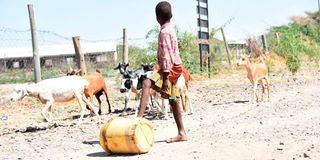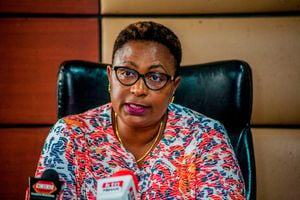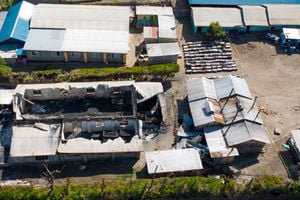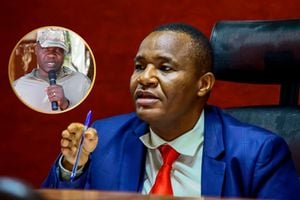How water scarcity is fuelling conflicts in North Rift

A gilrl pushes a jerrican of water at Lowareng’ak village in Turkana County on October 12, 2022 amid a biting drought.
What you need to know:
- Further north in Turkana County, which has one of the largest aquifers in the country, residents are still migrating to neighbouring countries in search of water for their livestock.
- Exploitation of the underground water in the county has been hampered by its high salinity.
Four in five people living in rural areas worldwide lack access to safe drinking water, according to the 2024 United Nations Water Development Report.
While water nurtures prosperity by meeting basic human needs, poverty, inequality, social tensions and conflict can amplify water insecurity.
In North Rift region, pressure on water resources is a major concern and source of conflict. Residents in Baringo South recount how the pursuit of water along Olarabal River has often turned deadly, especially when livestock is the currency of daily life.
“We have lost so many people along this river because this is where we all bring out cattle and goats to drink water, and sometimes when the livestock mix, conflict ensues as the neighbouring community from Tiaty sometimes insists that all the livestock are theirs,” says Harrison Lemegurian, a resident.
Gabon Chemute, another resident, notes that before Baringo County government sunk boreholes near their homesteads, women feared fetching water from the ravines on Olarabal because it meant life or death.
“We would walk for hours to and from the river and we always needed the men to keep watch lest we got attacked by bandits,” she explains.
To date, five counties along River Kerio are under a security operation due to livestock theft and often, the conflict is linked to access to pasture and water.
According to Baringo Governor Benjamin Cheboi, providing residents with access to clean water is a priority because it will reduce incidents of inter-communal conflict.
“In the last 10 years, there has been a huge transformation in terms of water access. In the 2022/2023 financial year, the average access to water in the county was 47 per cent. Within the last year, we have increased it by 13 per cent and now we are at 60 per cent,” he says.
Further north in Turkana County, which has one of the largest aquifers in the country, residents are still migrating to neighbouring countries in search of water for their livestock.
Exploitation of the underground water in the county has been hampered by its high salinity. “If we can introduce desalination plans, we will be able to give a good number of people access to water,” says Faith Aletea, the county’s Water executive.
According to Mr Cheboi, degradation of catchment areas is partly to blame for the water-related conflict experienced in Northern Kenya. He adds: “It is important for us to reverse environmental degradation to protect the water sources so that sufficient water can flow downstream.”
Along Njoro River, members Njoro River Water Resource Users Association (WRUA) are conducting a turbidity test. This involves scouring the river bed with a net and sieving the soil to reveal the living things inside the water. The living organisms found in this part of the river help the members of WRUA to know the quality of water at this juncture. This was part of the World Water Day celebrations in Nakuru County, where young environmental activists drawn from all over the country converged to plant trees along Njoro River’s riparian.
“The insects help us to know if the water is clean or dirty,” says Sylvester Koech, a Nessuit WRUA member.
“The pollution of water upstream is quite rampant; some people have cultivated along the riverbanks, some are allowing animals directly into the water, and there’s illegal harvesting of water, and that means those living downstream cannot access the water,” says Judy Wangui from Njoro WRUA.
Njoro River is sourced from 12 streams from the Mau Forest complex. Still, human activities within this catchment area have affected the quantity and quality of water in this permanent river that drains into Lake Nakuru.
“We know that water is a uniting factor for the young and the old because the system requires everyone,” says Kevin Odongo, the lead outreach officer for the Kenya Water Ambassadors.
As the water from the river pours into Lake Nakuru, it has coagulated with plastic waste in puddles that will be washed into the lake once the long rains resume.
According to the UN-Water Development report, water diplomacy will facilitate the political processes and practices to prevent, mitigate and resolve disputes over transboundary water resources and develop joint water governance arrangements. The report further states that universal access to drinking, sanitation and hygiene water will require an annual investment of around US $114 billion until 2030.





